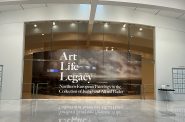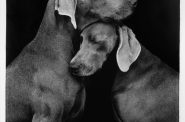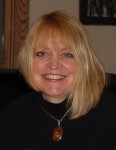Unquestionable passion
Do you know of Mildred Fish-Harnack?
I pose this question at the start, as it’s one of many I had at the opening reception at Madison’s UW Hillel/The Barbara Hochberg Center for Jewish Student Life for an exhibit intended as a memorial to this remarkable Wisconsin native.
And it leads me to the question of where to begin the conversation about an American girl who ended up being executed on February 16, 1943 following Hitler’s order. Who on earth would want that legacy? Yes, another question.
There is much to be said about Mildred (somehow, even in death, her personality reaches out and befriends). This woman with blue-collar roots in Milwaukee’s 26th and Highland neighborhood and average grades from West Division who went on to graduate from UW-Madison where she met Arvid Harnack.
They married and moved to Germany,where she became the first woman to teach at the Berlin University. No small feat for an American, much less a woman. At the same time, Mildred joined the resistance movement in Berlin that opposed Nazi violence and the war while lending support to forced laborers and persecuted Jews. No question this would end in a charge of high treason and a death sentence.
After entering the stunning contemporary Hochberg Center, I wandered up to the second level to hear an introductory talk by Franz Rudolf Knubel, the exhibit’s creator. Rather than explaining why this particular German would be honoring an American, anti-Nazi woman, his statements only raised more questions.
Knubel discussed his artwork related to 9/11 and how that propelled him back to his German roots. That said, we were released to view the show and ascertain for ourselves how he honored Mildred.
This memorial was to include photographs of relevant places in Mildred’s life, translations of a Johann Wolfgang von Goethe poem along with various documents. But an emphasis was placed on Knubel’s rubbings of the sacred places her feet touched.
Confusingly (and yet presciently), the exhibition sign displayed Knubel’s name larger than Mildred’s. The first level’s works were primarily about Knubel’s floor-to-ceiling banners containing delicate images and German text with English translations, which seemed to be more personal reflections about himself and his work interspersed with some images of buildings related to Mildred. Yet these few notations powerfully conveyed her personality and passion just as Van Gogh’s impasto brush stokes reveal his, inspiring a search for more details of her life.
Proceeding to the wall filled with banners, I found they held information that, finally, primarily reflected Mildred: translation notations, explanations about the Red Orchestra (the Gestapo’s term for the underground organization she was part of), and more photographs of places and spaces of her existence, but now with relevant statements regarding Mildred. A glimmer of hope arose.
On the third level, my search ended successfully, yet perplexingly. Tucked away in a corner was the treasure I’d been seeking. The wealth of information I sought lay on a long, unassuming wooden table in numerous thick, black binders.
These binders were the memorial to this incredible woman. Clearly organized within each notebook were photographs of Mildred throughout her life along with evocative information such as personal letters, legal documents, resistance flyers and newspaper articles. Mildred’s life accomplishments, and their repercussions, were presented through copies of aged pages that begged to be handled.
In perusing the binders, I serendipitously discovered an answer to one of my sets of questions: how exactly did Mildred’s sentence of six years penal servitude change to execution (which was her husband’s immediate sentence) and how directly was Hitler involved? One point within an extensive legal document stated that two days after sentencing, Hitler himself ordered the fateful retrial.
Also, it was a privilege to read one of Mildred’s job search letters that displayed the confidence of someone who would eventually catch the eye of Hitler. And a final gem was discovering that Mildred was warned of the danger of staying in Germany, and yet she chose to do so.
Hours could be spent here paying tribute.
One question that lingers is why Mildred Fish-Harnack, though honored in Germany, is relatively unknown in her hometown for her selfless efforts. Mildred’s passion and drive to remain and fight for the victims of the Nazi regime is evident in her last words before the guillotine cut short her life at 41:
“And I have loved Germany so much.”
That’s no question.
The Mildred Fish-Harnack memorial will remain on view on the UW-Madison Hillel Center until December 3, 2010. For more information, click here.
Art
-
Exhibit Tells Story of Vietnam War Resistors in the Military
 Mar 29th, 2024 by Bill Christofferson
Mar 29th, 2024 by Bill Christofferson
-
See Art Museum’s New Exhibit, ‘Portrait of the Collector’
 Sep 28th, 2023 by Sophie Bolich
Sep 28th, 2023 by Sophie Bolich
-
100 Years Of Memorable Photography
 Sep 18th, 2023 by Rose Balistreri
Sep 18th, 2023 by Rose Balistreri


















There must be so many women like Mildred that we don’t know about (since society has always stressed the work of men). I’m glad that at least there were black binders describing what she did, and her life, even if put in a non-dominant place (although that doesn’t sound right either!) No, I had never heard of her, and would guess that many others haven’t either, so I’m glad that you’ve make this information known to us!
Some of us are hoping to bring this exhibit to Milwaukee, within the next year, and after it closes in Madison on Dec. 3, 2010. But her example will not be suitably honored until there is substantial building named after her, perhaps an MPS school, as well as at the UW-Madison.
Art Heitzer
artheitzer@gmail.com
633 W. Wisconsin Ave., Suite 1410
Milwaukee, WI 53203 USA
414-273-1040, ex. 12; fax 414-273-4859
My grandfather was Donald R. Heath a US diplomat who was friends with the Harnack’s in Berlin. His son my uncle Donald Heath Jr. is still alive and has some amazing background that should be documented soon as my uncle is in his 80’s.
There is more to this story than has been published. If any student is truly interested in a research project on this email me and we can discuss an introduction to my uncle.
Richard Brown
rebrownlaw@aol.com